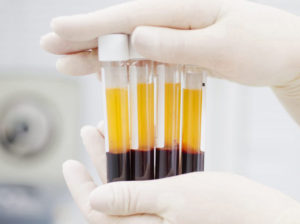What is Platelet Rich Plasma Therapy?
Platelet Rich Plasma Therapy (PRP) is blood plasma that has been enriched with platelets. As a concentrated source of autologous platelets, platelet rich plasma contains and releases through degranulation several different growth factors and other cytokines that stimulate the healing of bone and soft tissue.
Platelet Rich Plasma is produced from a person’s own blood. It is a concentration of one type of cell, platelets, which circulate through the blood and are critical for blood clotting. Platelets and the liquid plasma of the blood contain essential factors for the cell recruitment, multiplication and specialization required for healing.
How Does Platelet Rich Plasma Therapy Work?
PRP therapy uses the patient’s own blood cells. First a blood sample is obtained from the patient the blood is then put into a centrifuge. The centrifuge then separates the blood into its many components. The platelet rich plasma is then collected into a syringe to be delivered to an injured area of bone or soft tissue.
PRP is given to patients either through injection with fluoroscopy guidance to assist in precise placement of the PRP, or intravenously. After the injection, a patient should avoid exercise for a period of time before beginning a rehabilitation exercise program from Dr. Castillo.

Several studies suggest PRP Therapy can improve healing in many conditions. An increased number of platelet cells can improve tendon strength in Achilles tendon injuries. As well as improved muscle regeneration has been shown in calf muscle injuries after PRP.
These findings have led to the widespread use of PRP Therapy for a variety of conditions. Condition uses including acute and chronic tendon problems, as well as ligament and muscle injuries.
The most promising results with Platelet Rich Plasma Therapy have been for the use of treating chronic tendon injuries. Such tendon injuries include tennis elbow and Achilles tendonitis. In a small study involving knee osteoarthritis, PRP therapy was shown to be more effective than hyaluronic acid treatment. Platelet rich plasma has also shown positive results in the treatment of rotator cuff tears and MCL injuries in the knee.
Who is a candidate for Platelet Rich Plasma?
PRP therapy is advised for patients with moderate osteoarthritis in the hip, knee or shoulder. As well as patients who have chronic tendonitis in the elbow or ankle. Typically conservative treatment options have failed the patient in recovery; such as rest, medication, and physical therapy.
Does PRP consist of one or more injections?
The amount of injections is determined on a case-by-case basis. A physician will use the MRI or Ultrasound results to determine the number of injections. Typically it can take 1 to 3 rounds of injections, it depends on the type of pain.
Will there be a follow up?
Yes, Dr. Castillo will want to see you back to check the progress of healing. You will be asked to make a follow up appointment 6 weeks following the injection.
 Skip to content
Skip to content

